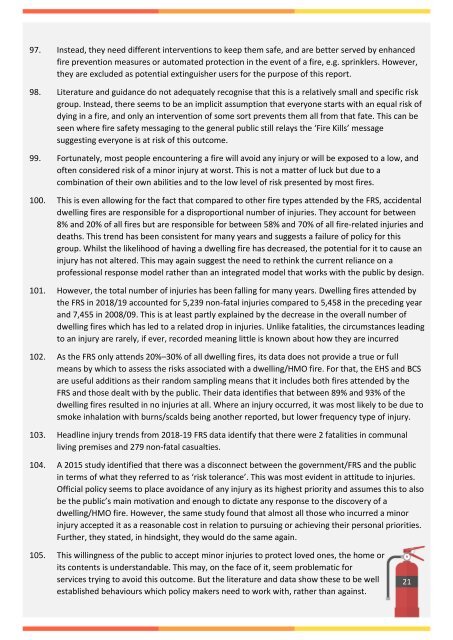An evaluation of the role of fire extinguishers
A report considering the role of a fire extinguisher in human terms identifying the gap between policy assumptions and the evidence from real fires. It considers the implications arising from this and makes a number of recommendations to create an evidence base and enhance current fire safety policies/advice.
A report considering the role of a fire extinguisher in human terms identifying the gap between policy assumptions and the evidence from real fires. It considers the implications arising from this and makes a number of recommendations to create an evidence base and enhance current fire safety policies/advice.
Create successful ePaper yourself
Turn your PDF publications into a flip-book with our unique Google optimized e-Paper software.
97. Instead, <strong>the</strong>y need different interventions to keep <strong>the</strong>m safe, and are better served by enhanced<br />
<strong>fire</strong> prevention measures or automated protection in <strong>the</strong> event <strong>of</strong> a <strong>fire</strong>, e.g. sprinklers. However,<br />
<strong>the</strong>y are excluded as potential extinguisher users for <strong>the</strong> purpose <strong>of</strong> this report.<br />
98. Literature and guidance do not adequately recognise that this is a relatively small and specific risk<br />
group. Instead, <strong>the</strong>re seems to be an implicit assumption that everyone starts with an equal risk <strong>of</strong><br />
dying in a <strong>fire</strong>, and only an intervention <strong>of</strong> some sort prevents <strong>the</strong>m all from that fate. This can be<br />
seen where <strong>fire</strong> safety messaging to <strong>the</strong> general public still relays <strong>the</strong> ‘Fire Kills’ message<br />
suggesting everyone is at risk <strong>of</strong> this outcome.<br />
99. Fortunately, most people encountering a <strong>fire</strong> will avoid any injury or will be exposed to a low, and<br />
<strong>of</strong>ten considered risk <strong>of</strong> a minor injury at worst. This is not a matter <strong>of</strong> luck but due to a<br />
combination <strong>of</strong> <strong>the</strong>ir own abilities and to <strong>the</strong> low level <strong>of</strong> risk presented by most <strong>fire</strong>s.<br />
100. This is even allowing for <strong>the</strong> fact that compared to o<strong>the</strong>r <strong>fire</strong> types attended by <strong>the</strong> FRS, accidental<br />
dwelling <strong>fire</strong>s are responsible for a disproportional number <strong>of</strong> injuries. They account for between<br />
8% and 20% <strong>of</strong> all <strong>fire</strong>s but are responsible for between 58% and 70% <strong>of</strong> all <strong>fire</strong>-related injuries and<br />
deaths. This trend has been consistent for many years and suggests a failure <strong>of</strong> policy for this<br />
group. Whilst <strong>the</strong> likelihood <strong>of</strong> having a dwelling <strong>fire</strong> has decreased, <strong>the</strong> potential for it to cause an<br />
injury has not altered. This may again suggest <strong>the</strong> need to rethink <strong>the</strong> current reliance on a<br />
pr<strong>of</strong>essional response model ra<strong>the</strong>r than an integrated model that works with <strong>the</strong> public by design.<br />
101. However, <strong>the</strong> total number <strong>of</strong> injuries has been falling for many years. Dwelling <strong>fire</strong>s attended by<br />
<strong>the</strong> FRS in 2018/19 accounted for 5,239 non-fatal injuries compared to 5,458 in <strong>the</strong> preceding year<br />
and 7,455 in 2008/09. This is at least partly explained by <strong>the</strong> decrease in <strong>the</strong> overall number <strong>of</strong><br />
dwelling <strong>fire</strong>s which has led to a related drop in injuries. Unlike fatalities, <strong>the</strong> circumstances leading<br />
to an injury are rarely, if ever, recorded meaning little is known about how <strong>the</strong>y are incurred<br />
102. As <strong>the</strong> FRS only attends 20%–30% <strong>of</strong> all dwelling <strong>fire</strong>s, its data does not provide a true or full<br />
means by which to assess <strong>the</strong> risks associated with a dwelling/HMO <strong>fire</strong>. For that, <strong>the</strong> EHS and BCS<br />
are useful additions as <strong>the</strong>ir random sampling means that it includes both <strong>fire</strong>s attended by <strong>the</strong><br />
FRS and those dealt with by <strong>the</strong> public. Their data identifies that between 89% and 93% <strong>of</strong> <strong>the</strong><br />
dwelling <strong>fire</strong>s resulted in no injuries at all. Where an injury occurred, it was most likely to be due to<br />
smoke inhalation with burns/scalds being ano<strong>the</strong>r reported, but lower frequency type <strong>of</strong> injury.<br />
103. Headline injury trends from 2018-19 FRS data identify that <strong>the</strong>re were 2 fatalities in communal<br />
living premises and 279 non-fatal casualties.<br />
104. A 2015 study identified that <strong>the</strong>re was a disconnect between <strong>the</strong> government/FRS and <strong>the</strong> public<br />
in terms <strong>of</strong> what <strong>the</strong>y referred to as ‘risk tolerance’. This was most evident in attitude to injuries.<br />
Official policy seems to place avoidance <strong>of</strong> any injury as its highest priority and assumes this to also<br />
be <strong>the</strong> public’s main motivation and enough to dictate any response to <strong>the</strong> discovery <strong>of</strong> a<br />
dwelling/HMO <strong>fire</strong>. However, <strong>the</strong> same study found that almost all those who incurred a minor<br />
injury accepted it as a reasonable cost in relation to pursuing or achieving <strong>the</strong>ir personal priorities.<br />
Fur<strong>the</strong>r, <strong>the</strong>y stated, in hindsight, <strong>the</strong>y would do <strong>the</strong> same again.<br />
105. This willingness <strong>of</strong> <strong>the</strong> public to accept minor injuries to protect loved ones, <strong>the</strong> home or<br />
its contents is understandable. This may, on <strong>the</strong> face <strong>of</strong> it, seem problematic for<br />
services trying to avoid this outcome. But <strong>the</strong> literature and data show <strong>the</strong>se to be well<br />
established behaviours which policy makers need to work with, ra<strong>the</strong>r than against.<br />
21<br />
19




